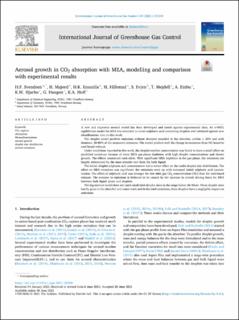| dc.contributor.author | Svendsen, Hallvard Fjøsne | |
| dc.contributor.author | Majeed, Hammad | |
| dc.contributor.author | Knuutila, Hanna K | |
| dc.contributor.author | Hillestad, Magne | |
| dc.contributor.author | Evjen, Sigvart | |
| dc.contributor.author | Mejdell, T. | |
| dc.contributor.author | Einbu, A. | |
| dc.contributor.author | Hjarbo, Kai Wilhelm | |
| dc.contributor.author | Haugen, G. | |
| dc.contributor.author | Hoff, K.A. | |
| dc.date.accessioned | 2022-09-12T08:12:25Z | |
| dc.date.available | 2022-09-12T08:12:25Z | |
| dc.date.created | 2021-09-06T12:41:27Z | |
| dc.date.issued | 2021 | |
| dc.identifier.citation | International Journal of Greenhouse Gas Control. 2021, 109 . | en_US |
| dc.identifier.issn | 1750-5836 | |
| dc.identifier.uri | https://hdl.handle.net/11250/3017116 | |
| dc.description.abstract | A new and improved aerosol model has been developed and tested against experimental data. An e-NRTL equilibrium model for MEA was extended to cover sulphuric acid containing droplets and validated against new eboulliometer data in this work. The droplet model predicts emissions without demister installed in the absorber, within ± 20% and with demister, 30-80% of the measured emissions. The model predicts well the change in emissions from NG-based to coal-based exhaust. Under conditions reported in this work, the droplet number concentration was found to have a small effect on predicted emissions because of more MEA gas-phase depletion with high droplet concentrations and slower growth. The effects counteract each other. With significant MEA depletion in the gas phase, the emissions are largely determined by the mass transfer rate from the bulk liquid. The initial droplet sulphuric acid concentration had a minor effect on the outlet droplet size distribution. The effect on MEA emissions was significant: the emissions went up with increased initial sulphuric acid concentration. The effect of sulphuric acid was stronger for low inlet gas CO2 concentration (NG) than for coal-based exhaust. The increase in emissions is believed to be caused by the increase in overall driving force for MEA between bulk liquid phase and droplets. The log-normal model does not catch small inlet droplet sizes in the range below 20-30nm. These droplet sizes hardly grow in the absorber and water wash and in the total emissions, these droplets have a negligible impact on emissions. | en_US |
| dc.language.iso | eng | en_US |
| dc.publisher | Elsevier | en_US |
| dc.rights | Navngivelse 4.0 Internasjonal | * |
| dc.rights.uri | http://creativecommons.org/licenses/by/4.0/deed.no | * |
| dc.subject | aerosol emissions | en_US |
| dc.subject | droplet size distribution | en_US |
| dc.subject | aerosol growth | en_US |
| dc.subject | Monoethanolamine | en_US |
| dc.subject | absorption | en_US |
| dc.subject | CO2 capture | en_US |
| dc.title | Aerosol growth in CO2 absorption with MEA, modelling and comparison with experimental results | en_US |
| dc.type | Peer reviewed | en_US |
| dc.type | Journal article | en_US |
| dc.description.version | publishedVersion | en_US |
| dc.rights.holder | © 2021 The Authors. Published by Elsevier Ltd. | en_US |
| dc.source.pagenumber | 17 | en_US |
| dc.source.volume | 109 | en_US |
| dc.source.journal | International Journal of Greenhouse Gas Control | en_US |
| dc.identifier.doi | 10.1016/j.ijggc.2021.103390 | |
| dc.identifier.cristin | 1931602 | |
| dc.source.articlenumber | 103390 | en_US |
| cristin.ispublished | true | |
| cristin.fulltext | original | |
| cristin.qualitycode | 1 | |

